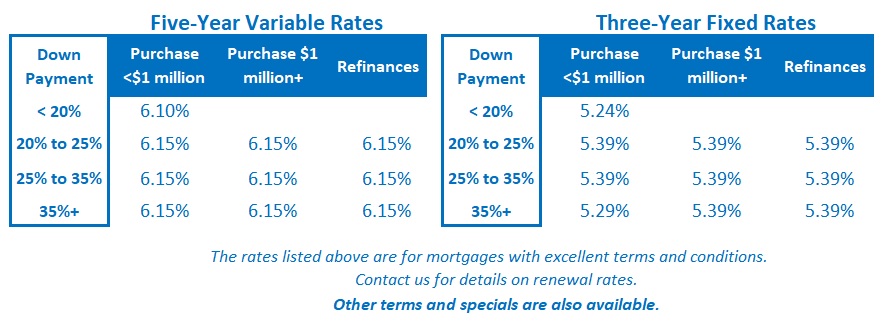Welcome Relief for Canadian Fixed-Rate Mortgage Borrowers
May 6, 2024Canadian Mortgage Rate Update – Top Five Recent Posts
May 21, 2024
Last week, Statistics Canada estimated that our economy added 90,000 new jobs in April.
That headline result, which was more than four times the consensus estimate of 20,000, appears to have dashed hopes that the Bank of Canada’s (BoC) first rate cut will materialize at its next meeting on June 5.
But should it have?
When key economic data are released, the bond market typically moves in response to the headline, which in this case meant driving Government of Canada (GoC) bond yields higher. But a more detailed look at underlying employment trends shows less strength than initially meets the eye. It leads me to conclude that this report probably won’t cause the BoC to alter its previous rate-cut plans.
Let’s start with a look at the good news that accompanied last month’s strong employment headline result:
- The 90,000 new jobs created in April represent our best monthly jobs print since January 2023.
- Most of the increase (68,000 jobs) occurred among people between the ages of 25 and 54. That core age group is considered the backbone of our labour market.
- The new jobs were spread evenly across Ontario, Quebec, British Columbia, and New Brunswick.
- Total hours worked also increased by 0.8% month-over-month.
- Average wages increased by 4.7% in April year-over-year. Average wages are now rising faster than overall inflation, which is currently 2.8%. That means the purchasing power of the average worker has continued to increase.
There is no denying that last month’s employment report showed more strength than was expected. But will it be enough to change the BoC’s rate-cut timing?
At its policy-rate meeting in April, the Bank observed “a broad range of indicators”, which confirmed that “labour market conditions continue to ease”. There were details in last month’s employment data to bolster that assessment:
- Our population growth is still outpacing job growth. CIBC economist Andrew Grantham noted that the size of our labour force expanded more rapidly than the number of jobs last month (107,000 vs 90,000), leading him to conclude that “the underlying trend remains one of loosening labour conditions”.
- Our unemployment rate now stands at its highest level since November 2017. It increased from 5.2% to 6.1% over the past year, and Stats Can noted that the increase was spread “across all major demographic groups”. In past economic cycles, an increase in the unemployment rate of 1% or more from its trough has been a very reliable predictor of imminent recessions.
- While average wages increased in April by 4.7% year-over-year, that result was a decrease from 5.1% in March, marking our slowest year-over-year growth rate in ten months.
- Our goods-producing sector lost 10,400 jobs last month. Wage growth in this sector has also eased from recent peaks. Goods-producing jobs tend to be higher paying, and they fuel labour demand in supporting industries downstream, so continued weakness in this sector will spread.
- Stats Can also recently confirmed that our GDP grew by 0.5% in January, by 0.2% in February, and is currently estimating that it stayed flat in March. This slowdown in GDP is occurring despite the boosts from record-high levels of immigration and unseasonally warm weather in many parts of the country in the first quarter. In the months ahead, the steady slowing in our overall economic momentum will likely cause labour demand to soften further.
In summary, despite the headline jobs numbers, I don’t expect last week’s employment report to cause the BoC to adjust its rate-cut timetable, especially if our next round of inflation data, due next Tuesday (May 21), confirms that prices have continued to cool.
The Bank’s current monetary policy rate of 5% is highly restrictive, well above the neutral rate, and by its own admission, the risks of leaving it unchanged are increasing.
For example, only about half of Canadian mortgage borrowers have had to renew their mortgages at this point. The other half who have yet to renew will experience much greater payment shocks if rates remain at their current levels, because most of those borrowers will be resetting mortgage rates that were locked in at pandemic lows.
Those coming mortgage-rate resets are a stark real-world example of how the BoC’s rate hikes impact our economy with a lag. Their delayed impact will ensure that our financial conditions will continue to tighten until rate cuts finally materialize.
For my part, I think the Bank will look through our latest employment print because the longer-term trends of slowing economic growth and loosening labour-market conditions remain intact. Looking ahead, the resetting payments on the half of our outstanding residential mortgages still to be renewed at higher rates will further cool demand and therefore prices.  The Bottom Line: GoC bond yields were range bound last week until the latest employment data pushed them higher on Friday. For the reasons outlined above, I don’t expect this momentum to carry into the early part of this week. If that assessment is correct, our fixed mortgage rates will remain at current levels.
The Bottom Line: GoC bond yields were range bound last week until the latest employment data pushed them higher on Friday. For the reasons outlined above, I don’t expect this momentum to carry into the early part of this week. If that assessment is correct, our fixed mortgage rates will remain at current levels.
Five-year variable-rate discounts have widened of late. I believe that we will soon see BoC rate cuts, very possibly next month, despite last month’s stronger-than-expected employment headline.







